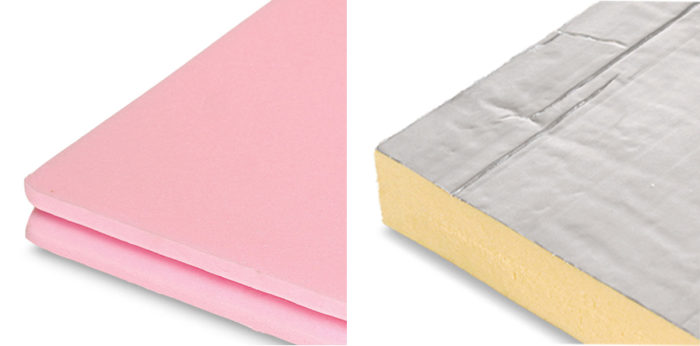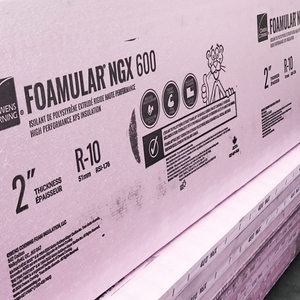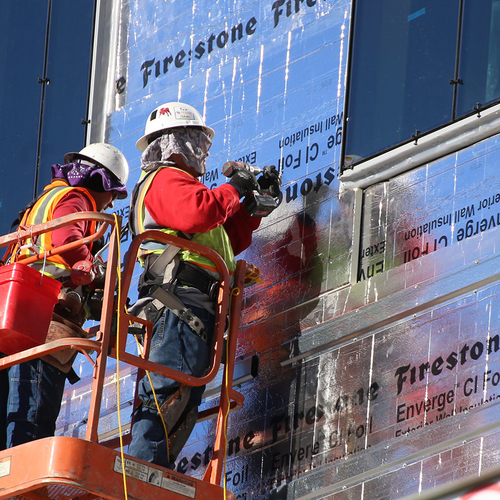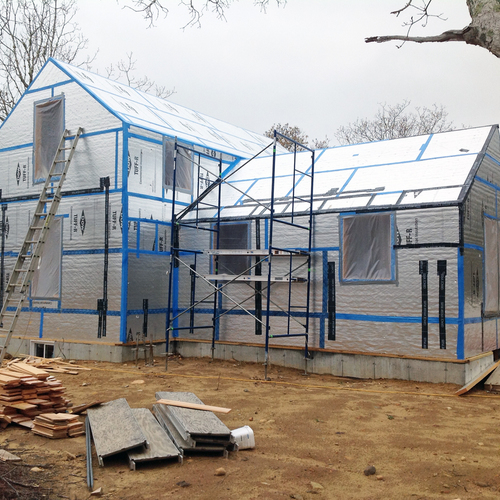
Most insulation materials have an R-value lower than R-5.6 per inch. As David Yarbrough, a nationally known insulation expert, explains, “At 75°F, the theoretical maximum R-value of a product is 5.6 per inch. That represents the maximum R-value if there is no convection and no radiation — it represents the pure conductivity of air. That’s as high as you can go unless you are talking about a product that incorporates encapsulated gas, or a vacuum, or nano-scale powders.”
Since this is a theoretical maximum, it isn’t surprising to learn that cellulose, mineral wool, fiberglass, and EPS generally have somewhat lower R-values (in the range of R-3.5 to R-4.2 per inch).
Why have many manufacturers of polyisocyanurate, at least until recently, been touting R-values that are higher than this theoretical maximum? Because polyiso (like extruded polystyrene) includes encapsulated gas; as Yarbrough noted, insulation products with encapsulated gas can exceed the theoretical maximum R-value of R-5.6 per inch.
If the bubbles of air found in foam insulation are replaced with bubbles of a different gas — a gas with lower vapor conductivity than air — it’s possible to achieve a higher R-value. The blowing agents used to produce polyiso and extruded polystyrene (XPS) fall into this category.
Thermal drift
Although the blowing agents used to produce polyiso and XPS successfully increase the R-value of newly manufactured rigid foam, they have an Achilles’ heel: over time, these blowing agents dissipate. The gases gradually diffuse through the rigid foam, and as they dissipate, they are replaced by air. (Covering the rigid foam with a vapor-impermeable facing like aluminum foil slows, but does not prevent, this process.) Because this process results in a gradual reduction in the foam’s R-value, it’s often referred to as “thermal drift.”
The blowing agents used to make expanded polystyrene…
Weekly Newsletter
Get building science and energy efficiency advice, plus special offers, in your inbox.

This article is only available to GBA Prime Members
Sign up for a free trial and get instant access to this article as well as GBA’s complete library of premium articles and construction details.
Start Free TrialAlready a member? Log in















21 Comments
Response to Charlie Sullivan
Charlie,
Thanks for catching my typo (which I have corrected).
We must have been thinking along the same lines this morning. Ten minutes ago, I made a few last-minute edits to my piece, including a mention of Neopor in my final bullet point. After making the edit, I read your comment, which also noted the advantage of Neopor. So, needless to say, I agree with you. Thanks.
Does size matter?
Martin: does the rate of R-value loss differ with the thickness of the foam? Would a meter thick foam end up at R 4 at the same time as a millimetre thick f oam?
Does the location matter? Under slab v. In a wall?
Response to Stephen Sheehy
Stephen,
Thickness definitely matters -- which is why Dow's guarantee only applies to XPS that is at least 1 1/2 inch thick. (The obvious implication is that the R-value of 3/4-inch XPS or 1-inch XPS drops off faster than for thicker types of XPS.)
I don't think that anyone can answer your question about subslab XPS vs. wall-mounted XPS -- but we can all speculate.
Thanks for digging into this!
Nice piece of investigation, Martin- well worth the effort!
I would expect 2lb polyurethane blown with HFC and HFO agents to have the same issues, but not water blown 2lb polyurethane, since the water dissipates quickly.
Icynene's 2.0 and 2.1lb water blown foams run about R5/inch, and is probably an indication of where most 2lb polyurethane would end up (but over how long is still an open question.)
The smaller regional player Aloha Energy's water blown polyurethane claims as much as R6.5/inch at some unspecified density, but third party ASTM C518 testing data doesn't seem to be available online.
http://www.aloha-energy.com/spray_foam.html
"
* 4 Foam Density Products available 0.5lb, 1.0lb and 1.8lb and 2.5lb
* Provides an R-Value of 3.6 to 6.5 per inch, depending on foam density "
Response to Dana Dorsett
Dana,
John Straube told me, "You know, installers of closed-cell spray foam sometimes brag, ‘We’re spraying foam at R-7 an inch.’ Maybe it’s R-7 instantly, right after you spray it, but after just a little bit of aging, you won’t getting anything near that. We’ve never seen any foam that achieves R-7. You may be spraying it, but it doesn’t make it to my lab. Lots of people make claims but no one is checking."
That sounds right to me.
Some 2lb foam vendors are claiming R7/inch, but I'm a skeptic on that too.
I'm a bit surprised at just how poorly HFC-blown XPS can perform at the tender age of 3 years (or even 3 months!). I had been assuming that it would probably still be in the ~R5-ish range or higher at least to the ripe age of 5, but clearly that can't be counted on. I've long held the notion that assuming anything more than R4.2/inch for reclaimed or well-aged XPS isn't appropriate from a design perspective, but given the Richard Roe's third party tested performance table included in this article the age & condition no longer factors into my thinking. Even brand-new XPS cannot be assumed to be higher than R4.2/inch long enough to matter. (And I thank you again for that!)
Thanks, and a stable way to boost R
Thanks for digging into this! It's disappointing that the XPS industry isn't able or willing to say much useful. I hope that by asking the questions and publishing this you are helping to make them realize they need to do more. And thanks for boiling it down into practical assumptions to make for now, in the absence of better information.
A useful footnote is that if you want to have higher R-value than EPS, but don't want drift, you can get ~R4.5/in with graphite-loaded EPS. It's branded Neopor by BASF, and rebranded under various other names by insulation companies, such as "insulfoam platinum." Unless carpenter ants carry away bits of it, the R-value won't change over time.
In Europe, the XPS industry offers CO2 blown graphite loaded XPS. Stable R value and negligible global warming impact. Too bad they don't offer that here.
"Regular" EPS vs. Neopor
Martin finishes the blog with the reference to graphite infused Neopor EPS. I am planning to use 6 1/2" EPS SIPs on my new home for the walls. (EPS core is 5 1/2" thick) Manufacturer rates the EPS panels at R-23, Neopor at R-27. Is it likely to be worth a cost premium for the Neopor over the EPS for an added R-4? Or is that bump in R negligible for the added cost?
It depends...
Whether the additional cost of graphite loaded EPS is "worth a cost premium" depends a lot on the limitations of how thick the wall can be. A 7.5" - 8" EPS SIP would have comparable (or better) performance to a 6.5" Neopor SIP.
I haven't personally priced Neopor in $/R-ft^2 (let alone Neopor SIPs vs. standard EPS), but anticipate that it's going to be more expensive per unit-R. Do the math. Where you can tolerate the additional thickness a standard EPS is probably going to be more cost effective.
If you are constrained to 6.5", a bump from R23 to R27 is a double digit percentage reduction in heat flow- it's not nothing. But whether the net performance gain for the whole house is cheaper at a given wall thickness by bumping up to Neopor vs. better windows or some other change is something the designer needs to work out.
Response to James Kreyling Re whether Neopor is worth it.
Like Dana says, we'd have to know the cost premium to know whether it's worth it. You can, as he says, compare that to increasing the thickness, or to improving the envelope elsewhere. We can also quickly and easily calculate the annual heat loss through the walls in the two cases and calculate the heating system energy use difference, if we know the type of heating system and the heating degree days for your location. And we can calculate how much PV you'd need to buy to cover that difference.
Under a slab, making the insulation thicker is possible for only the cost of the insulation. A thicker wall, however, increases other costs such for the details needed at windows and doors. So even if a thicker SIP is a cheaper way to get an R-27 rated wall panel, the total project cost might still be lower with the thinner Neopor.
But that's all just speculation until we have numbers for what they are charging as a premium for the Neopor.
Neopor Payback
I was interested in using Neopor, researched it when we were planning our SIP home. Looking back through my emails to our GC reminds me that I had studied BASF's independent lab testing reports etc. I recall being convinced it was the way to go. Ultimately we didn't use it; the payback wasn't there for us, much the same as it wasn't for triple pane windows.
Found a 4 year old email to our GC that has a screen shot where I used a simple online energy calculator to determine whether Neopor would be beneficial for our roof. (Ignore the actual chosen materials, they were picked to provide the correct R value differential. We also don't use fuel oil; I assume I either entered it as a worst case assumption, or this tool had no provision for ground source heat pump HVAC.)
At 37cents/R-ft^2 at high-R I'm not suprised it doesn't work.
The calculation shows 2160 square feet of R4 at a cost of $3205.44. That's $1.484 per square foot for R4, or $0.371 per square foot per R. That's pretty expensive performance enhancement ...
...~3.5x as expensive per R as standard EPS ...
...~2x as expensive per R as closed cell spray polyurethane...
...~10x as expensive per R of open blown cellulose in an attic.
Foil faced XPS?
Should the manufactures not produce a foil faced XPS? It sounds like a foil face could reduce the thermal drift by reducing the blowing agents from off gassing through the two faces of the panels. It would also make a nice surface for taping panels compared to how the panels are currently manufactured. Of course this would increase the cost of manufacturing and hence the panel. For most customers price means a lot, especially when they may only be looking at the R-value when comparing products.
I wonder what the internal pressure of the foams individual cells is before and after off gassing. I would think that the pressure would drop. Could this be the cause of the foam panel shrinkage? Is it a direct result of the off gassing, and would a foil face help reduce this?
Oh yeah, and how about a question for the manufactures. How would I go about having my foam tested for an R-value to possibly cash in on the warranty, and is the warranty transferable? I think it is convenient for the manufactures that it is not probable you would ever be able to test your foam board to make sure it retains 90% of the R-value 20 to 50 years later. If there are local labs for testing R-values of foam and the warranty is transferable, my friend Craig has a list with a lot of reclaimed foam board for sale that could be swapped for new.
Response to Dillon Vautrin
Dillon,
First of all, several Chinese manufacturers produce foil-faced XPS. Here is a link to a web site describing such a product:
http://www.alibaba.com/product-detail/aluminum-foil-XPS-Foam-Insulation-sheet_60070364186.html?spm=a2700.7724857.29.10.efOqv4&s=p
Second, here is contact information for a lab that can determine the R-value of an XPS sample or other types of insulation:
R & D Services
102 Mill Drive
Cookeville, TN 38501
931-372-8871
Offgassing toxicity
This is slightly off-topic of R-value, but I'm wondering: If the blowing agent is slowly being released, does this create any air-quality concerns when used inside a structure, say for insulating basement walls.
Response to Adam Liberman
Adam,
The rate at which the blowing agent diffuses is quite slow -- the process takes decades -- so the concentration of blowing agent in the indoor air is likely to be very, very low. Moreover, I don't know of any reports that these blowing agents are toxic. (I'm not saying they aren't, but I've never heard that they are -- especially at the remarkably low levels under discussion).
If the idea of blowing agents diffusing into the air is worrisome to you, choose EPS.
HFC blowing agents aren't toxic
The biggest safety hazards with HFCs are frostbite from contact with liquids. At concentrations of over 500,000 ppm HFC134a has been shown to cause cardiac symptoms in dogs, but that's a concentration only achievable by opening up a can of automotive refrigerant in an unventilated room.
The fire retardents used in rigid foam are probably a bigger human-health issue than slow bleed down of the HFCs over years/decades, and even those might be tough to measure. In most houses you're probably at bigger risk from the VOCs in cleaning solutions and scented products.
Extruded Polystyrene Association (XPSA) Response
Determining R-value by focusing on thermal drift is not a comprehensive way of evaluating long-term thermal performance (LTTR) of foam insulation. Thermal drift is just one part of several heat transfer mechanisms that should be considered when accurately determining the thermal performance of foam insulation.
The three main heat transfer mechanisms to consider when determining an R-value are convection, conduction, and radiation. Heat transfer through these mechanisms varies based on the physical properties of different foams (e.g. density, cell size, polymer composition, gas phase composition), as well as environmental factors (e.g. aging, temperature, climate). Over the years, the foam insulation industry has never ceased to improve upon and make advancements in the thermal performance of foams with regards to all three mechanisms of heat transfer.
In light of the number of variables, and variety of methods to determine LTTR values through accelerated aging, and variety of types of insulation, the foam insulation industry’s consensus has been to evaluate R-value at 180 days at a 75 degree mean temperature in order to determine R-values for comparative performance, which gives you the average R-value in the second stage of aging. The industry evaluates R-values by ASTM C518 or C177 standards because they are uniform test methods that can be applied to all foam plastics.
Think of it like when you consider buying a car and ask how it is on gas mileage. You’re given a number in average miles per gallon that the industry has also calculated based on a set of variables. If those variables change (e.g. gas octane level, city traffic, condition of the carburetor, going up or down hill, age of the car), the average miles per gallon may change.
Much like the gas mileage analogy, the LTTR for foam insulations is not a fixed value due to the physical and environmental variations. Blowing agents are required in the foam plastic extrusion process to create desirable thermal performance qualities. And, while it is scientifically accurate that the slow diffusion of a blowing agent out of and diffusion of air into XPS foam minimally decreases its R-value over an extended period of time, the closed-cell structure of XPS rigid foam insulation allows XPS to retain significant thermal efficiency throughout its lifecycle, even after the 15-year weighted LTTR testing period. This is important to note because while other types of foam insulation claim to not have “thermal drift” because of differences in the manufacturing process, their products still allow penetration and absorption of moisture, reducing the foam’s insulation power and, ultimately, its R-value.
XPS insulation contributes significantly to a building’s energy efficiency and performance durability due to its very high compressive strength and moisture resistance, making it a sustainable and energy efficient choice for designers. When considering recommendations for foam insulation, make sure to do your research and consider all of the variables to make an informed decision that is right for your specific need.
The Extruded Polystyrene Association is happy to serve as a resource. Additional information can also be found at http://www.xpsa.com.
Regards,
Laura Meditz, Communications Manager, XPSA
Response to Laura Meditz
Laura,
Thanks very much for your comments, which seem to confirm the facts reported in my article.
One of your sentences is a little puzzling: "Thermal drift is just one part of several heat transfer mechanisms that should be considered when accurately determining the thermal performance of foam insulation."
Thermal drift is not "part of a heat transfer mechanism". As you correctly point out, there are just three heat transfer mechanisms relevant to insulation performance: convection, conduction, and radiation. Thermal drift is a shorthand phrase to describe the gradual reduction in insulation performance for some types of rigid foam. It is not "one part of a heat transfer mechanism."
The heat transfer mechanisms that govern heat flow through XPS after thermal drift reduces the R-value of the foam are exactly the same heat transfer mechanisms that govern heat flow through XPS before thermal drift reduces the R-value of the foam.
Way to go, Martin. Takes me back to the days of Energy Design Update.
I find it useful to have that theoretical maximum R value as a reference point. To get higher than that you might have to sell your soul to the devil, or at least delude yourself. But if you accept that your insulation R value per inch is lower you can design around that. Yes, construction details will need to account for the thicker assemblies but your soul will be intact. This is where I'm at with the wood fiber insulations: reconcile yourself to the need for a greater thickness of insulation and just make some cool architectural details.
One thing that strikes me as I see those blowing agent numbers thrown around, most of those are extremely potent greenhouse gases. Some of them are ozone-depleting substances. That 100% of the blowing agent will be released under normal use is sobering. Wood fiber doesn't use synthetic blowing agents. Just do it.
And finally, you don't mention the phenolic foams, which claim an even higher R value per inch than polyiso. Any thermal drift information there?
lyoung, I just want to correct one detail--no insulation commonly available today uses blowing agents that include ozone-depleting compounds, thanks to the Montreal Protocol, a success story of international cooperation. Otherwise I'm with you. For many years now, long before we have settled on design details, I have drawn exterior walls at anywhere from 8" to 18" thick, but usually 12", so we don't end up with constraints. When I see 6" walls on plan sets now, they look puny.
Log in or become a member to post a comment.
Sign up Log in